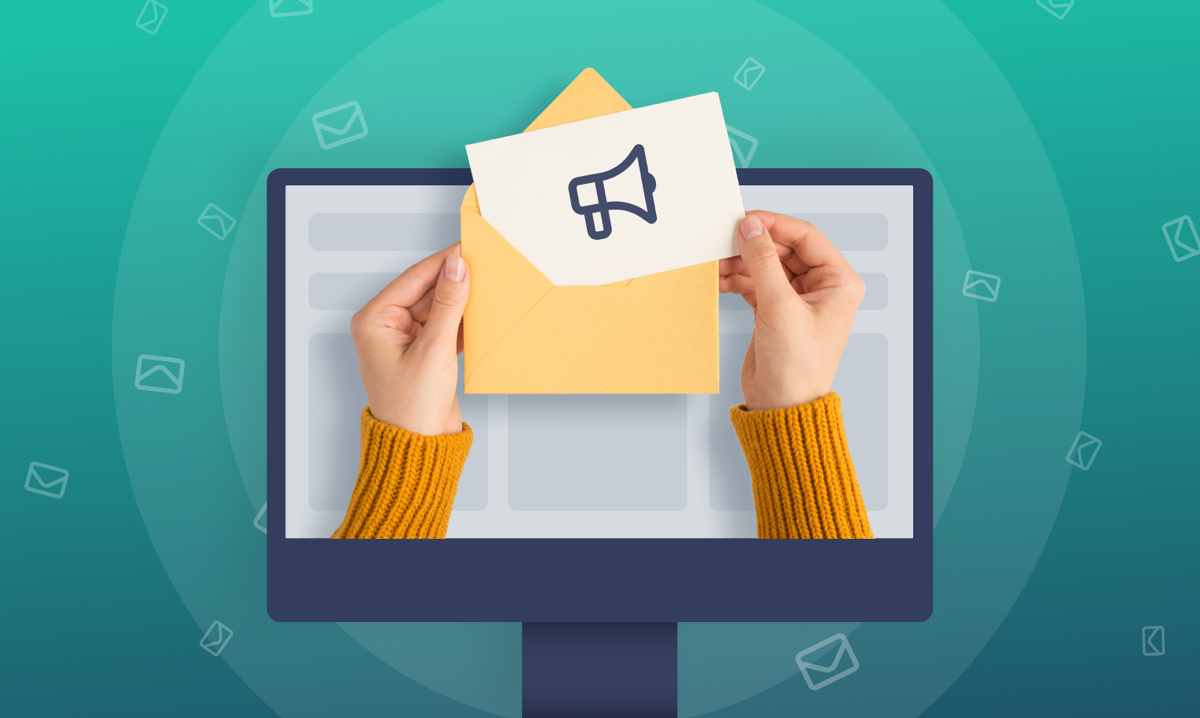
Email marketing has become an essential tool for insurance agencies and brokers, offering a direct and personal way to connect with potential and existing clients. It helps nurture leads, build trust, increase conversions, and even win back lost or inactive clients—all while being cost-effective. In this guide, we’ll explore why email marketing is highly relevant and beneficial for insurance agencies and brokers and how it can help drive sales using the latest insurance automation trends.
Why Email Marketing Matters for Insurance Agencies and Brokers
With 319.6 billion emails sent daily and over 4.14 billion global email users, email marketing remains one of the most effective communication channels. It is particularly impactful in the insurance industry, where relationships and trust play a vital role in client acquisition and retention.
ROI of Email Marketing in Insurance:
- Average ROI: For every $1 spent, email marketing delivers an average return of $36.
- Insurance-Specific Benefits: For insurance brokers and agencies, email marketing is a cost-effective way to engage leads, retain clients, and cross-sell policies, significantly boosting overall sales.
These statistics underline the immense potential of email marketing as a critical component of digital strategies for insurance agencies and brokers.
Benefits of Email Marketing for Insurance Brokers and Agencies
Email marketing has transformed how insurance agencies and brokers engage with clients, making it an indispensable tool for nurturing leads, retaining customers, and driving sales. Below are the key benefits and insights on how this strategy can enhance operations and profitability.
- Building Trust: Consistent, informative emails help establish credibility—critical in an industry where customers must feel confident in their decisions. Example: Sending personalized policy reminders or tips on filing claims builds a sense of reliability and professionalism.
- Personalized Client Engagement: Segment email lists by policy type, customer demographics, or stage in the buyer’s journey to send tailored, relevant messages. Example: A clients should receive tailored content on life insurance, while a homeowner could get updates on home insurance policies.
- Cost-Effective Communication: Compared to traditional marketing methods, email marketing allows for personalized outreach without the hefty price tag.
- Customer Lifecycle Management: Automated campaigns ensure continuous communication, from on-boarding to policy renewal reminders, strengthening customer loyalty.
- Cross-Selling and Up-selling Opportunities: Use email to highlight additional products or upgraded plans, such as bundling home and auto insurance policies.
Insurance email automation allows marketers to send communications automatically when subscribers hit certain triggers (like filling out a form for a quote or abandoning their cart). It also helps marketers send emails at peak times, reduce administration tasks, and analyze their marketing data.
Studies show that 65% of marketers use automation in email marketing. There are many email marketing automation options available today, including insurance industry-specific ones like PathwayPort. PathwayPorts’s Marketing Automation helps you automate by distributing your emails, collecting and interpreting data.
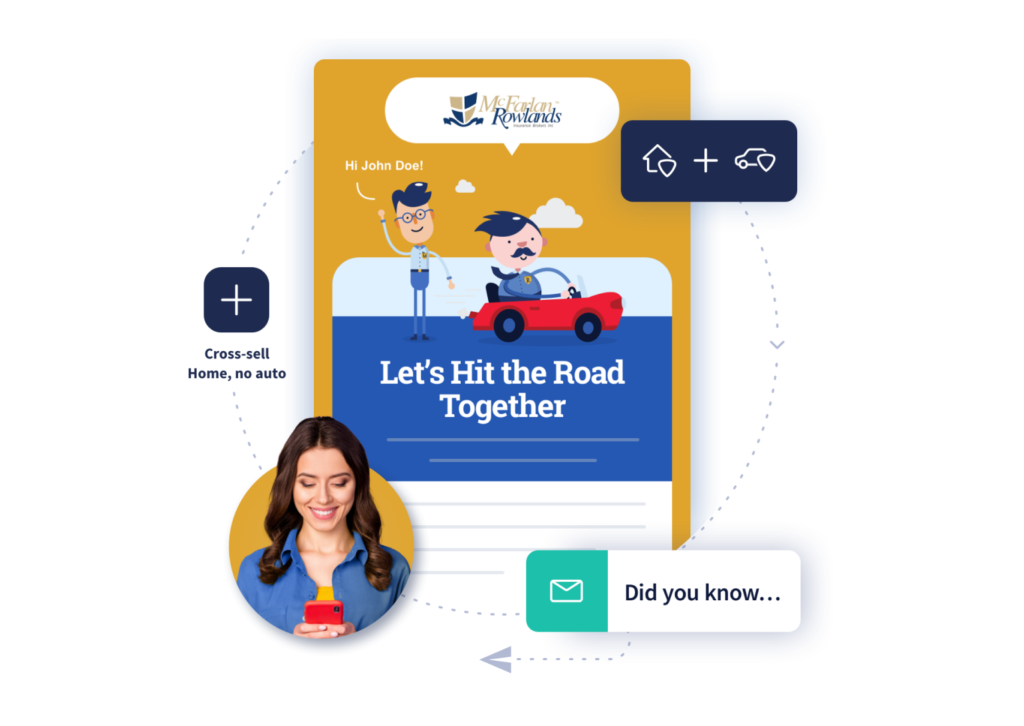
Email Marketing Tips to Supercharge Your Insurance Campaigns
All email marketing campaigns are not created equal. Some campaigns excite readers and convert them with unique tactics. Other campaigns fail to stand out in a crowded inbox.
Below are six tips to help you supercharge your sales with insurance email marketing campaigns.
1. Build a Robust Email List
When insurance companies plan an email marketing campaign, they often focus on the contents of emails. This focus is vital but pointless if you don’t have a robust email list.
Put simply, your email list is the group of people who have signed up to receive your marketing communications. The list includes people’s email addresses, names, and any other data they’ve given you (age, gender, location, etc.).
You can’t just take your customers’ email addresses and add them to your email list — your subscribers must provide consent by clicking on a box that says something like this:
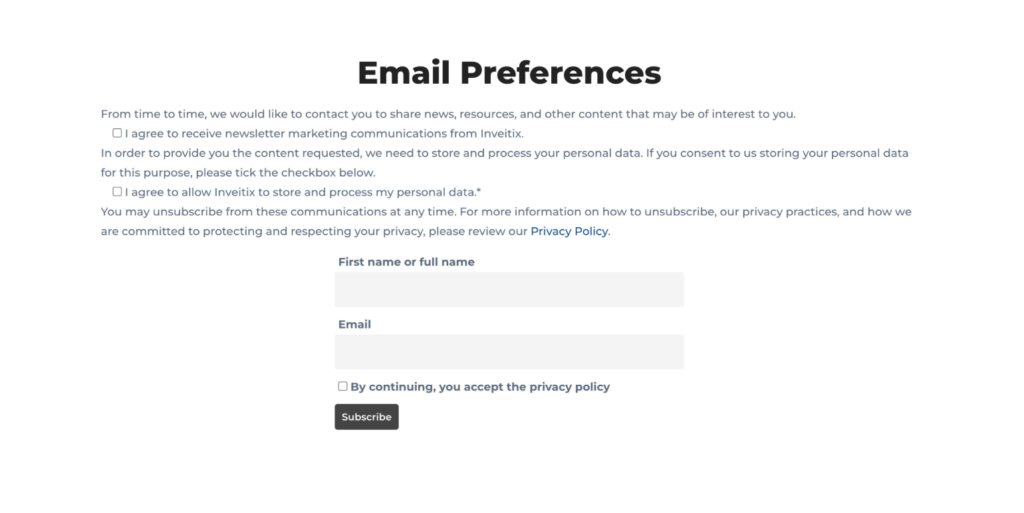
Source: VolaSoftware
Now, people don’t just join email addresses for no reason. So how do you get people to sign up? Try these strategies:
Use a Lead Magnet
As the name suggests, a lead magnet is something that appeals to people to the point they would give you their email address in exchange. Examples of lead magnets include industry reports, eBooks, printables, high-quality images, how-to guides, templates, and lists (like below).
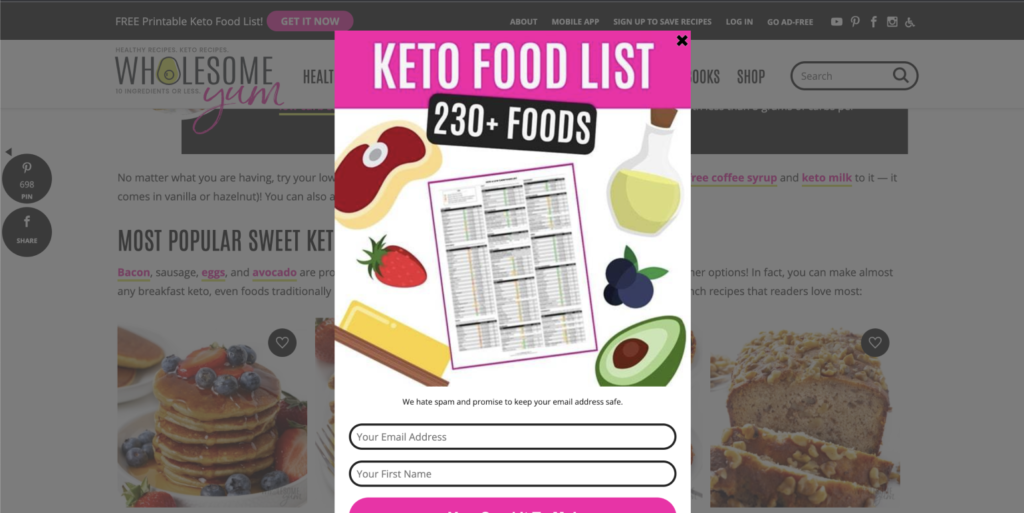
Source: WholesomeYum
Some businesses also offer physical lead magnets like calendars (though this could get expensive quickly if you serve policyholders in a large area).
You can develop a lead magnet by identifying information your potential customers need but can’t currently find easily. For example, an insurance agency that offers boat insurance could create a 50-page booklet with expert tips for new boat owners.
Offer Insurers an Emailed Copy of Their Quote
Many insurance agencies and brokerages have forms on their websites that leads can fill out to see what a specific plan would cost them. To use this form to get sign-ups, offer to send leads a printable copy of their quote in exchange for their email address.
Offer a Monetary Reward
Lead magnets work great for niche products, but they don’t suit every customer. This fact isn’t true of discounts — almost no one wants to pay more when they don’t have to.
If you choose to give people a discount in exchange for their email address, make sure you make it large enough that it’s appealing but not so big that it devalues your offerings. Discounts between 15% and 30% walk this line well.
A great way to make sure your lead converts quickly is to place a time limit on their reward. You need to place urgency to your offer. Two days to one week is a good limit. Any longer and people will forget, and any shorter, and people might not have enough time to make an informed purchasing decision.
Add Non-Monetary Value
Finally, try offering leads extra value or services for their email address. For example, you could offer access to an exclusive tool or a scheduled consultation with an insurance expert that can review their coverage and provide expert advice.
2. Share a Mix of Content
Your readers are busy, so they won’t sit down and read your marketing emails like a novel no matter how much they support your business.
The number of email users worldwide is projected to reach 4.6 billion by 2025, underscoring the extensive reach of email as a communication tool.
These dips aren’t outliers to ignore. Forbes notes that “recently, people are spending less time reading brand emails,” and though it doesn’t give a reason, it’s not hard to imagine several. People now use their devices for various purposes and often have competing tabs and tasks. Millions of brands are now also vying for people’s attention using email marketing.
Whatever the reason, the takeaway is clear: you need to make your emails memorable and engaging to keep people reading.
One way to do this is by sharing a mixture of marketing content to keep things fresh. For example, you can share:
- Welcome emails. These greet new subscribers and provide a first impression. Welcome emails typically have the highest engagement rates.
- Onboarding emails. These draw readers in by offering help with onboarding and access to resources like your FAQ section and knowledge base.
- Cross-selling emails. These show subscribers’ plans and services complementary to things they’ve already purchased (for example, you could send your car insurance customers a cross-selling email for camper and trailer insurance).
- Up-selling emails. These offer subscribers upgrades to their current plan.
- Cart abandonment emails. These emails remind customers to complete a purchase they started.
- Seasonal greeting emails. These build your relationship with leads and customers by wishing them well. They are also a great chance to offer a seasonal discount or coupon.
- Themed emails. These use current or seasonal events to grab people’s attention (for example, you could send car insurance customers an email about driving safely in snow over winter).
- Sales emails. These emails give subscribers access to exclusive discounts.
- Updates on new policies. These emails inform customers about new plans your company offers.
If subscribers know they aren’t going to see the same type of email every time, they’re more likely to click on your email.
Another way to keep emails engaging is to leverage your email design. You can use white or negative space to draw people’s eyes to key sections or your CTA. Additionally, you can use color to create a warm and friendly atmosphere, clever copy-writing to get a reaction from readers, and videos, gifs, and images to share information in an easily digestible way.
After you’ve nailed your design, consider switching up the contents of each section to keep emails unique. Use fresh photos, new copy-writing, and unique phrasing for your CTA.
3. Be Consistent With Your Newsletters and Outreach
It’s natural for your motivation to send marketing emails to be highest when you first start your email campaign. However, you need to try and maintain that effort, or else it will cost your campaign long-term.
Consistency matters the most when it comes to newsletters and outreach. In both cases, people will recognize your branding and come to expect particular things. If you don’t deliver, you will disrupt the trust you’ve built.
To keep your newsletters consistent and high-quality, feature the same sections in each email and alter the content. For example, you could include a featured article, a section linking to blog posts, a social media post, and a question from a customer (+ an answer).
Generally, you should also keep your styles, colors, and branding consistent so your marketing is easily recognizable as yours. However, feel free to change up fonts, images, shades, shapes, and phrasing to make your emails visually interesting.
These tips are also true of your outreach emails — they should look like “yours.”
With outreach emails, you also want to make your emails complementary so people are more likely to read multiple. You can do this by referencing your other outreach emails. For example, you could put “(part 1)” and “(part 2)” in the subject line or use phrases like “in our last email, we shared that…” and summarize the previous email. Additionally, add a teaser for the next email and tell customers when to expect it. This last trick will build anticipation.
Timing is also important for both newsletters and outreach emails. Let’s cover that next.
4. Find the Right Email Frequency for Your Lists
Email marketing campaigns are like rolling snowballs — they grow bigger as they gather more momentum. The best way to keep your brand rolling is to build a regular email marketing schedule that puts your emails in front of customers during optimum times.
For best results, account for three categories of marketing emails in your schedule:
- Weekly emails. This list should include your newsletter.
- Monthly emails. This list should include sales emails and customer education emails.
- Quarterly emails. This includes seasonal emails, themed emails, and updates about your company.
You don’t need to draft all these emails upfront. Instead, aim to have them ready for publishing at least 48 hours before you are due to send them out.
Now, when it comes to when you should publish each email specifically, you should look to research. Research from HubSpot on marketing emails shows that:
- People open more marketing emails on Tuesday and Thursday (open rate is 20%);
- People press more CTAs on Tuesdays/Thursdays (Click-Through Rate (CTR) is 2.2%);
- People press “unsubscribe” least often on Sundays (Sunday’s unsubscribe rate is 0.1%);
- Best time to send emails are: early mornings (8 AM -11 AM) or afternoons (1 PM to 3PM).
People engage with emails fairly consistently throughout the workday, with spikes in the early morning and late evening.
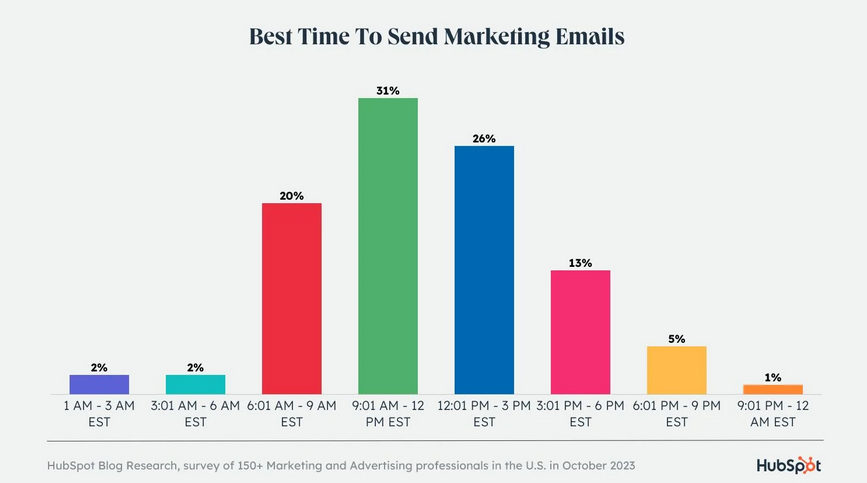
Source: HubSpot
Take this research as a guide, but look at your own email marketing statistics as well. Your subscribers are unique, and you might notice trends that indicate they like to receive emails at different times than the average consumer.
Now, some marketing emails won’t apply to your whole email list, including trigger-driven emails. Trigger-driven emails are the ones your marketing tool sends to customers automatically when they take a set action.
To get the most from trigger-driven emails, try setting up a mini-schedule that ensures you get the best response from subscribers. For example, you might send a cart abandonment email 24 hours after the lead abandons their cart. Then, you might send a re-engagement email 48-hours and 72-hours later.
It’s important to send these emails at the perfect time. If they are too close together, readers will get annoyed and hit “unsubscribe,” and if they aren’t close enough together, readers will lose interest. Put at least one day between each email, and never send more than five emails in one week.
5. Provide Value to Your Recipients
One of the fastest ways to lose email readers is by filling your emails with fluffy content that fails to capture their imagination or inspire them to click your CTA. You need to provide value.
However, this doesn’t mean you should overload your email with thousands of words, as readers are likely to see long paragraphs and hit “back.” Instead, focus on delivering new, unique, and actionable information.
For example, an email from the insurance provider RACV shares tips on how people can make their homes more resilient to wildfires. This topic is widely appealing and covers information that most people may not be familiar with—making it an excellent subject for email marketing.
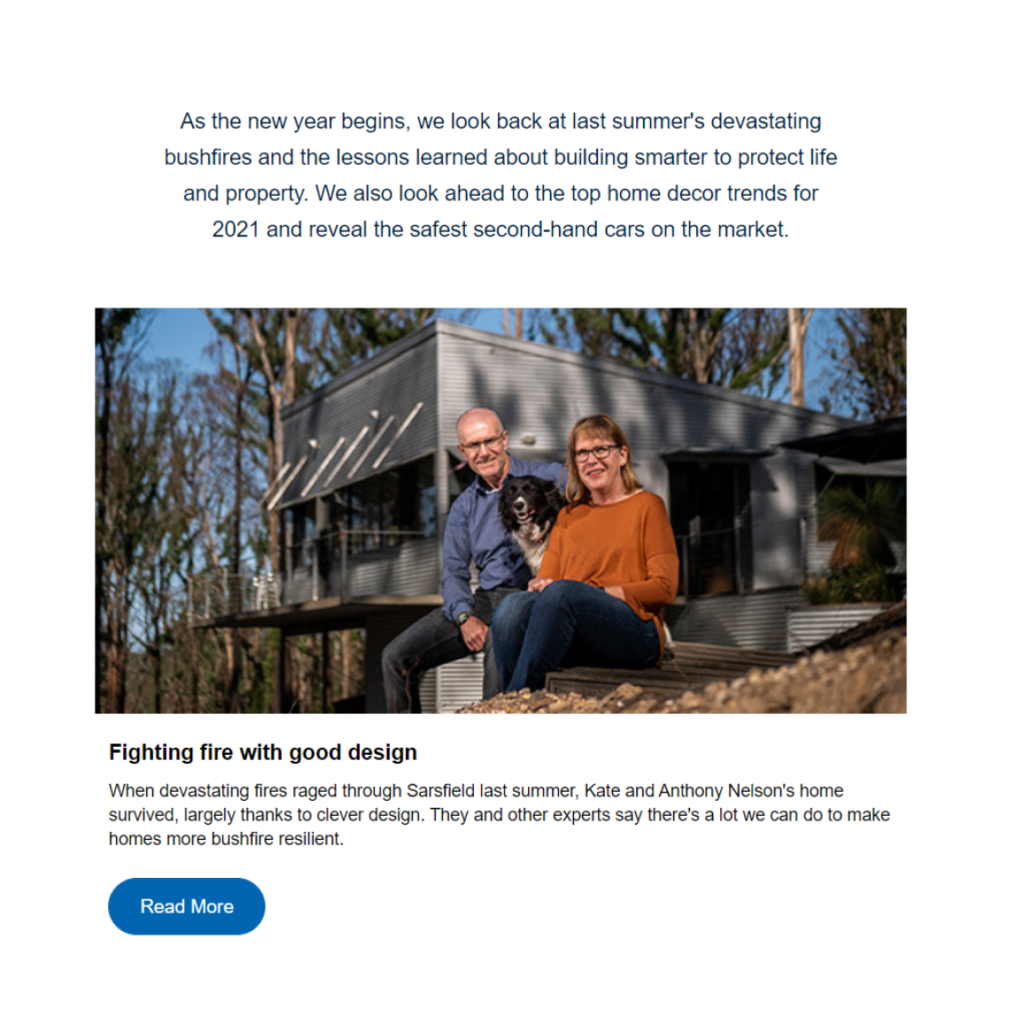
Aside from providing unique ideas, there are other ways you can provide value. Try:
- Adding links to blog posts that explore topics in-depth;
- Providing lists, best practices, case studies, etc.;
- Embedding social media posts into your emails;
- Creating custom infographics and charts to demonstrate key points;
- Adding short videos to your email (only 47% of businesses use videos, so this will make your email stand out!);
- Linking content they can print like checklists or templates.
Ideally, you shouldn’t use all these ideas in the same email. Doing so would make your emails confusing and far too long. Instead, use different strategies in every email to keep your content fresh and exciting.
6. Measure, Optimize, and Repeat
Your success with email marketing relies on your ability to adapt your content to your target audience’s requirements and preferences. Therefore, you’ll need to evaluate your marketing carefully to determine what works and what doesn’t.
When assessing your emails, focus on key statistics such as:
- Open Rate: The rate at which subscribers open your emails.
- Click Rate: The rate at which subscribers click on links within your emails (clicks and opens are not the same, as some readers may click “back” before the email fully loads).
- CTR (Click-Through Rate): The rate at which subscribers take a desired action, such as clicking on your CTA (Call-to-Action) or a link.
- Inbox Rate (also called “Deliverability Rate”): The rate at which your emails successfully land in subscribers’ inboxes.
- Spam Complaint Rate: The rate at which recipients report your emails as spam.
- Unsubscribe Rate: The rate at which subscribers opt out of your email list.
- List Growth: The rate at which your subscriber list grows (e.g., through sign-ups when users fill out forms, subscribe to newsletters, etc.).
After observing these metrics for a while, you’ll gain an understanding of what “normal” looks like for your brand. If you notice any significant deviations, it indicates that you are doing something either positively or negatively impactful. Once you identify the factors influencing your email performance, use that information to optimize your upcoming email campaigns.
PathwayPort offers email marketing automation with a large, comprehensive database of pre-written email templates tailored to different sectors of the insurance industry (life, car, health insurance, etc.). These templates have already been tested for effectiveness, so you won’t need to spend time on trial and error—you’ll have access to email messages that are proven to work.
Grow Your Email Marketing Campaigns With PathwayPort!
Whether you’re a local brokerage, a national insurance chain, or an insurance agency, email marketing isn’t a channel you can ignore. When you plan and execute an email strategy effectively, email marketing can build a relationship with customers, help you nurture leads, and boost your revenue through cross and up-selling. If you would like to learn more about the best marketing automation practices in insurance, read our blog article.
To boost your email marketing campaigns, make sure you focus on building a strong email list, send emails consistently, walk the line between “super helpful” and “spam” carefully, and share good content.
And, of course, use PathwayPort’s! You can find range of tools that can supercharge your insurance marketing, including:
- Marketing Automation, which automates your insurance email marketing efforts;
- Business Process Automation, which automates your insurance administration tasks and streamlines operations;
- Forms, which gives customers a way to fill out forms digitally, saving time;
- Self-Service Kiosk, which helps clients manage their own insurance.
If you’d like to try Pathway, sign up here.
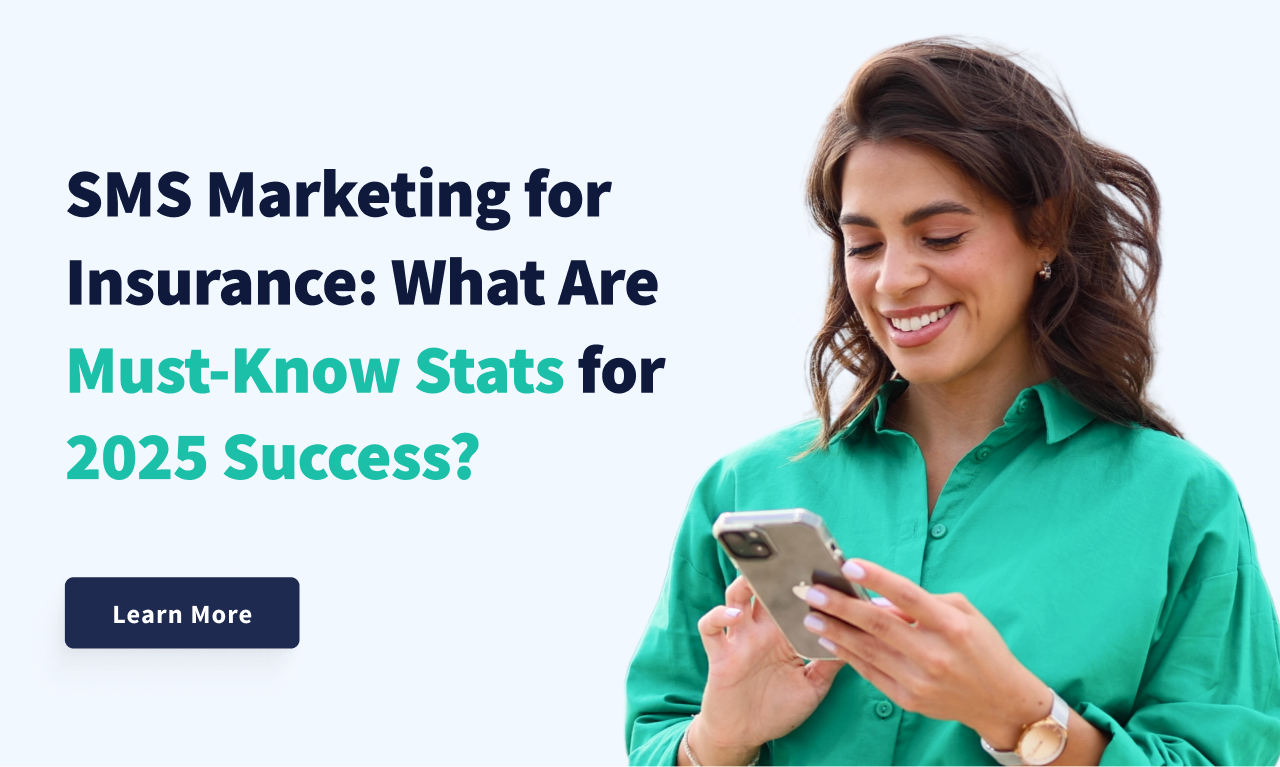
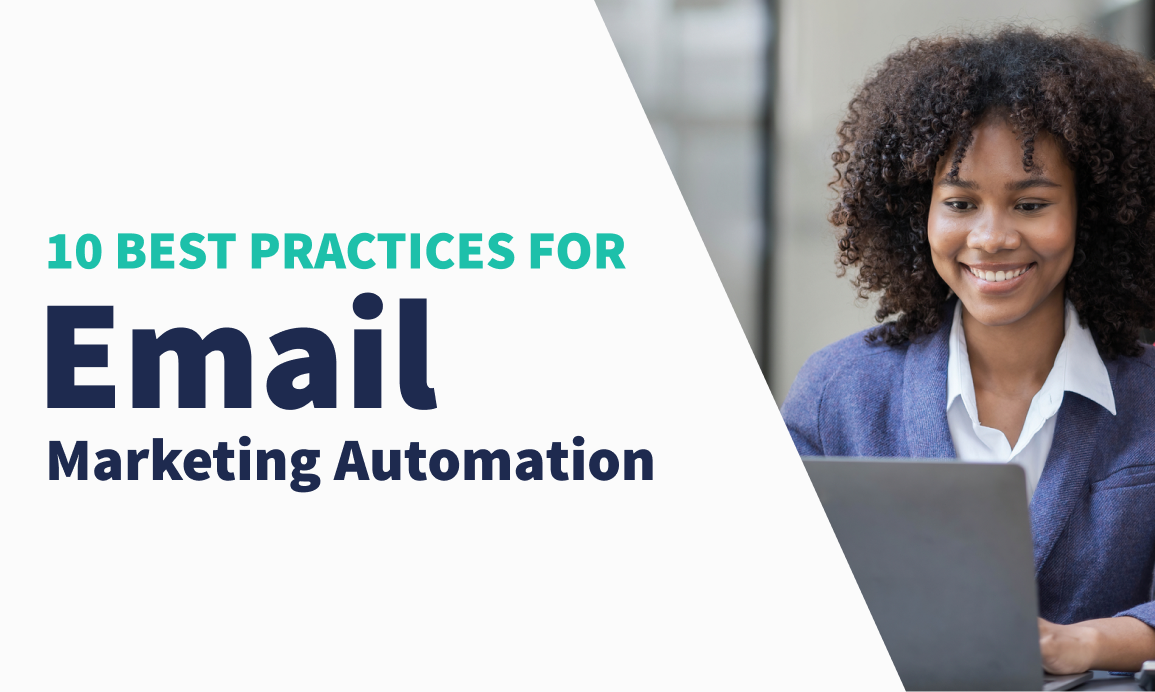

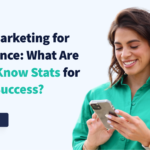
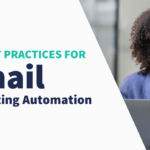
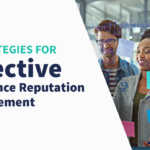
Leave a Comment